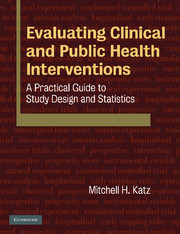 Evaluating Clinical and Public Health Interventions
Evaluating Clinical and Public Health Interventions Published online by Cambridge University Press: 10 May 2010
How do you translate research into practice?
Many highly skilled researchers – able to develop, implement, and evaluate cutting-edge interventions – often fall short on the last, and most important, stage of the process: translating their research into practice.
Much of the problem is that the people who develop and evaluate interventions are usually academics, and academia is primarily concerned with generating new knowledge. Translating interventions into the messy world of government bureaucracies, public health departments, and social service agencies, as well as dealing with political and funding challenges, has never been the focus of academic work.
With medication and medical devices there exists a machinery – drug companies and medical device suppliers – to translate research findings into practice, including convincing doctors to prescribe them, patients to take them, and insurance companies to pay for them. No comparable machinery exists for behavioral or structural interventions (e.g., changes to the physical environment, changes to the law). Political leaders, public health and social service practitioners and advocates do not typically read research journals, and when they do they are often unsure how to translate projects that were conducted in a research setting into practice.
This gap between knowledge generation and program adoption must be bridged if we are to take full advantage of newly developed interventions. There are a number of steps that researchers can take to make translation of their work easier:
Design interventions that are translatable.
Articulate the benefits of the intervention in terms people will understand and be motivated by.
[…]
To save this book to your Kindle, first ensure no-reply@cambridge.org is added to your Approved Personal Document E-mail List under your Personal Document Settings on the Manage Your Content and Devices page of your Amazon account. Then enter the ‘name’ part of your Kindle email address below. Find out more about saving to your Kindle.
Note you can select to save to either the @free.kindle.com or @kindle.com variations. ‘@free.kindle.com’ emails are free but can only be saved to your device when it is connected to wi-fi. ‘@kindle.com’ emails can be delivered even when you are not connected to wi-fi, but note that service fees apply.
Find out more about the Kindle Personal Document Service.
To save content items to your account, please confirm that you agree to abide by our usage policies. If this is the first time you use this feature, you will be asked to authorise Cambridge Core to connect with your account. Find out more about saving content to Dropbox.
To save content items to your account, please confirm that you agree to abide by our usage policies. If this is the first time you use this feature, you will be asked to authorise Cambridge Core to connect with your account. Find out more about saving content to Google Drive.